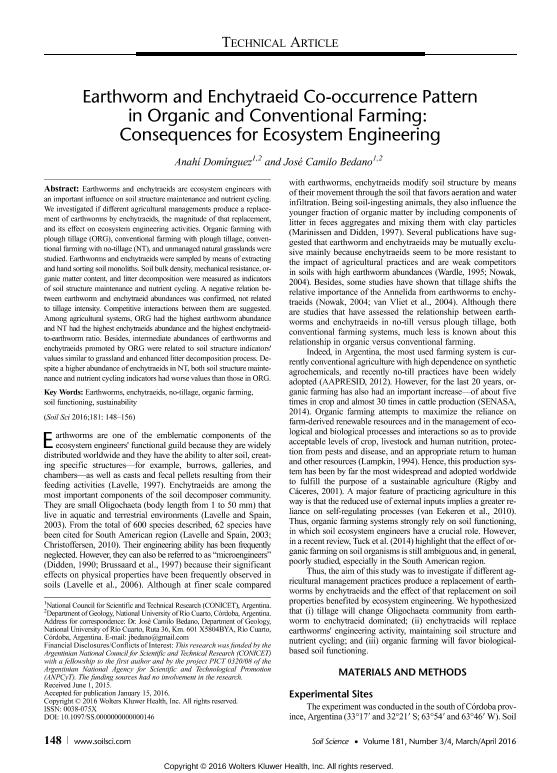Mostrar el registro sencillo del ítem
dc.contributor.author
Domínguez, Anahí

dc.contributor.author
Bedano, José Camilo

dc.date.available
2022-11-30T19:43:30Z
dc.date.issued
2016-01
dc.identifier.citation
Domínguez, Anahí; Bedano, José Camilo; Earthworm and enchytraeid co-occurrence pattern in organic and conventional farming: Consequences for ecosystem engineering; Lippincott Williams; Soil Science; 181; 3-4; 1-2016; 148-156
dc.identifier.issn
0038-075X
dc.identifier.uri
http://hdl.handle.net/11336/179642
dc.description.abstract
Earthworms and enchytraeids are ecosystem engineers with an important influence on soil structure maintenance and nutrient cycling. We investigated if different agricultural managements produce a replacement of earthworms by enchytraeids, the magnitude of that replacement, and its effect on ecosystem engineering activities. Organic farming with plough tillage (ORG), conventional farming with plough tillage, conventional farming with no-tillage (NT), and unmanaged natural grasslands were studied. Earthworms and enchytraeids were sampled by means of extracting and hand sorting soil monoliths. Soil bulk density, mechanical resistance, organic matter content, and litter decomposition were measured as indicators of soil structure maintenance and nutrient cycling. A negative relation between earthworm and enchytraeid abundances was confirmed, not related to tillage intensity. Competitive interactions between them are suggested. Among agricultural systems, ORG had the highest earthworm abundance and NT had the highest enchytraeids abundance and the highest enchytraeid-to-earthworm ratio. Besides, intermediate abundances of earthworms and enchytraeids promoted by ORG were related to soil structure indicators' values similar to grassland and enhanced litter decomposition process. Despite a higher abundance of enchytraeids in NT, both soil structure maintenance and nutrient cycling indicators had worse values than those in ORG.
dc.format
application/pdf
dc.language.iso
eng
dc.publisher
Lippincott Williams

dc.rights
info:eu-repo/semantics/openAccess
dc.rights.uri
https://creativecommons.org/licenses/by-nc-sa/2.5/ar/
dc.subject
EARTHWORMS
dc.subject
ENCHYTRAEIDS
dc.subject
NO-TILLAGE
dc.subject
ORGANIC FARMING
dc.subject
SOIL FUNCTIONING
dc.subject
SUSTAINABILITY
dc.subject.classification
Ecología

dc.subject.classification
Ciencias Biológicas

dc.subject.classification
CIENCIAS NATURALES Y EXACTAS

dc.title
Earthworm and enchytraeid co-occurrence pattern in organic and conventional farming: Consequences for ecosystem engineering
dc.type
info:eu-repo/semantics/article
dc.type
info:ar-repo/semantics/artículo
dc.type
info:eu-repo/semantics/publishedVersion
dc.date.updated
2022-11-30T12:06:57Z
dc.journal.volume
181
dc.journal.number
3-4
dc.journal.pagination
148-156
dc.journal.pais
Estados Unidos

dc.journal.ciudad
Philadelphia
dc.description.fil
Fil: Domínguez, Anahí. Consejo Nacional de Investigaciones Científicas y Técnicas; Argentina. Universidad Nacional de Río Cuarto. Facultad de Ciencias Exactas, Fisicoquímicas y Naturales. Departamento de Geología; Argentina
dc.description.fil
Fil: Bedano, José Camilo. Consejo Nacional de Investigaciones Científicas y Técnicas; Argentina. Universidad Nacional de Río Cuarto; Argentina
dc.journal.title
Soil Science

dc.relation.alternativeid
info:eu-repo/semantics/altIdentifier/doi/http://dx.doi.org/ 10.1097/SS.0000000000000146
dc.relation.alternativeid
info:eu-repo/semantics/altIdentifier/url/https://journals.lww.com/soilsci/Abstract/2016/03000/Earthworm_and_Enchytraeid_Co_occurrence_Pattern_in.6.aspx
Archivos asociados
